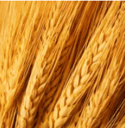Wheat Futures
 If it had not been for wheat, human beings may never have socially and culturally developed as cosmopolitan as we have. Wheat was the first crop to be cultivated on a grand scale and stored long-term, enabling the start of city-based societies and the dawning of civilization. When wheat is traded on the commodities markets, it must be classified into very specific classes according to grain properties. As a result, farmers usually try to predict which class of wheat will be the most successful in the futures markets.
If it had not been for wheat, human beings may never have socially and culturally developed as cosmopolitan as we have. Wheat was the first crop to be cultivated on a grand scale and stored long-term, enabling the start of city-based societies and the dawning of civilization. When wheat is traded on the commodities markets, it must be classified into very specific classes according to grain properties. As a result, farmers usually try to predict which class of wheat will be the most successful in the futures markets.
Wheat Contract Specifications
→ Click Here for Wheat Contract Specifications
Wheat Facts
According to the U.S. Department of Agriculture (USDA), wheat ranks third among U.S. field crops, behind corn and soybeans. Although U.S. wheat planted area has trended down over the years, the U.S. remains to be a major wheat producer. Nearly half of the U.S. wheat crop is exported as the world wheat consumption is continuing to expand due to rising population and incomes.
There are five major classes of wheat grown in the U.S. Each crop is slightly different from the other, growing in seperate regions and used for various purposes. Hard red winter wheat is the number one export in the United States.
Hard Red Winter Wheat (HRW)
- The largest of the US wheat crops
- Grown in Great Plains Regions
- Primarily used for bread making, can be used as a substitute for livestock feed
Hard Red Spring Wheat (HRS)
- The largest of the US wheat crops
- Grown in Northern Plains Regions
- Valued for high protein levels, can be used for specialty breads
Soft Red Winter Wheat (SRW)
- The first modern futures contract was for Soft Red Winter Wheat
- Grown east of the Mississippi River in more humid environments
- Suitable for milling
- Processed into flour, mainly used for cakes and flour-based snacks
White Wheat
- Grown in Washington, Oregon, Idaho, Michigan, and New York
- Primarily used as flour for noodle products, crackers, cereals, and white-crusted breads
Durum Wheat
- Grown primarily in North Dakota and Montana
- Used in the production of pasta
Key Terms
- Protein Content: Protein is the major compound in wheat. Protein content is a key specification to determine the usage for the particular wheat. Low protein content is used to make snacks or cakes while high protein content is necessary for breadmaking.
- Yield: Also referred to as “agricultural output”, crop yield is the measurement of the amount of crop that was harvested per unit of land area.
Last updated October 2015.